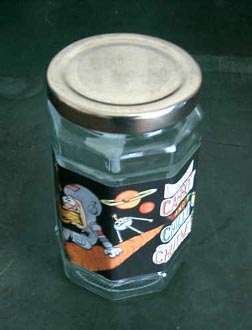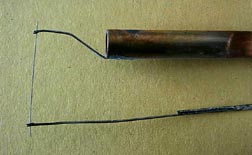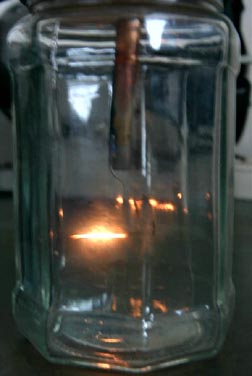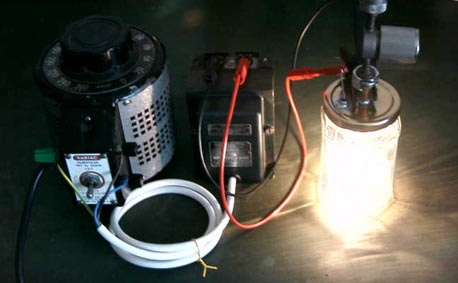
The Pickle Jar Lamp Experiment
An incandescent lamp requires two main things in order to function.
Obviously some sort of conductive filament is required, through which
electric current is passed to heat it. There also needs to be a transparent
air tight envelope for the filament, which is either evacuated or filled
with an inert gas. The filament has to be heated to over 1000C to emit
white light. If this were done in air, the filament would oxidize and
burn out.
 This is the envelope for the lamp. It's a jar which once contained
carrot and chilli chutney
This is the envelope for the lamp. It's a jar which once contained
carrot and chilli chutney
To enable the jar to be evacuated, a hole was drilled in the lid, a
copper tube passed through and soldered around the hole to seal it.
Another hole was drilled in the lid and a feed-through capacitor
soldered in to provide an air tight electrical connection into the jar.
 The filament was made from a 30mm length of 0.2mm diameter tungsten wire.
Thick copper wire was soldered to the pumping tube and to the feed-through
capacitor. The copper wire was crimped on to the tungsten filament (solder
would just melt).
The filament was made from a 30mm length of 0.2mm diameter tungsten wire.
Thick copper wire was soldered to the pumping tube and to the feed-through
capacitor. The copper wire was crimped on to the tungsten filament (solder
would just melt).

The jar was evacuated using a two stage rotary pump. The valve is to enable
the evacuated jar to be detached from the hose.
If you decide to try this, wear goggles incase the jar implodes.
 Here the filament is lit dimly so that it can be seen glowing. This is mainly
to make sure you don't think I'm cheating in the next picture.
Here the filament is lit dimly so that it can be seen glowing. This is mainly
to make sure you don't think I'm cheating in the next picture.
 Maximum power!
Maximum power!
The lamp was powered using a small variac (variable auto transformer) and
a step down transformer. The lamp requires high current and low voltage
because the filament resistance is very low. In the photo the lamp is
operating at about 3.5Vrms. The step down transformer is from an old
'Superspeed' soldering iron.
 This is the envelope for the lamp. It's a jar which once contained
carrot and chilli chutney
This is the envelope for the lamp. It's a jar which once contained
carrot and chilli chutney
 The filament was made from a 30mm length of 0.2mm diameter tungsten wire.
Thick copper wire was soldered to the pumping tube and to the feed-through
capacitor. The copper wire was crimped on to the tungsten filament (solder
would just melt).
The filament was made from a 30mm length of 0.2mm diameter tungsten wire.
Thick copper wire was soldered to the pumping tube and to the feed-through
capacitor. The copper wire was crimped on to the tungsten filament (solder
would just melt).
 Here the filament is lit dimly so that it can be seen glowing. This is mainly
to make sure you don't think I'm cheating in the next picture.
Here the filament is lit dimly so that it can be seen glowing. This is mainly
to make sure you don't think I'm cheating in the next picture. Maximum power!
Maximum power!